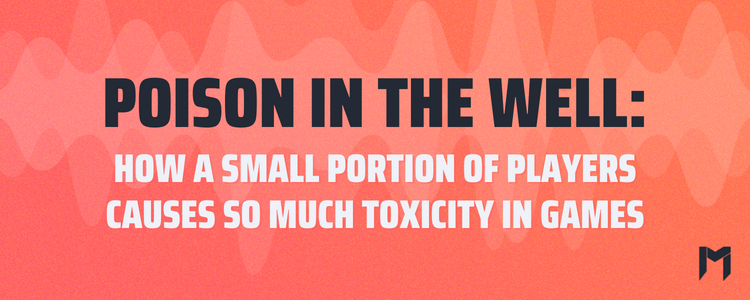
[Webinar] Poison in the Well: How a Small Portion of Players Causes So Much Toxicity in Games
Anyone who has tried to engage in voice chat while playing a multiplayer game understands the potential of encountering toxicity. This has long been accepted as “just how it is,” a status quo that can’t be improved upon, the price of admission for playing games online. But did you know that it’s really only a small portion of players (6%!) that cause more than 90% of toxic interactions?
Join Modulate’s Hank Howie and Daniel Kelley from the Anti-Defamation League in an engaging and dynamic webinar to discuss why this is the case, how that compares to other forms of media and community, and what we can all do to keep online games fun while eliminating the toxic elements that can cause real harm to players.
Tuesday, December 13 at 2pm ET
Panelists
.png?width=220&height=220&name=Poison%20in%20the%20Well%20-%20Hank%20circle%20headshot%20(1).png)
Hank Howie
Game Industry Evangelist
Modulate
Hank Howie (he/him/his) is a 30-year veteran of the computer game industry. He shipped his first game in 1991 as the Producer and Designer of Konami’s J.R.R. Tolkien Riders of Rohan game. Hank was a founding member and President of Blue Fang Games, the studio that created the best-selling Zoo Tycoon franchise, published in partnership with Microsoft Corp., as well as World of Zoo, published by THQ. Hank subsequently served as VP Global Business Development and COO at Disruptor Beam, where he signed and managed the franchises for the mobile games Star Trek Timelines, Game of Thrones Ascent and The Walking Dead: March to War. Today, Hank is the Game Industry Evangelist for Modulate, the company making voice chat safer for everyone with its ToxMod voice-native moderation platform.
 Morgan Clark
Morgan Clark
Assistant Director of Research and Policy
Anti-Defamation League Center for Technology and Society
Morgan Clark is the Assistant Director of Research and Policy in the Center for Technology Studies (CTS) at the Anti-Defamation League (ADL). She is currently an ABD graduate student in sociology at Northwestern University. Her research focuses on how the new technologies have changed how violence against women is conducted and understood, both legally and socially.
.png?width=220&height=220&name=Poison%20in%20the%20Well%20-%20Daniel%20circle%20headshot%20(1).png)
Daniel Kelley
Director of Strategy and Operations
Anti-Defamation League Center for Technology and Society
Daniel Kelley (he/him/his) is the Director of Strategy and Operations of the Anti-Defamation League (ADL) Center for Technology and Society (CTS). CTS works through research and advocacy to fight for justice and fair treatment for all in digital social spaces from social media to online games and beyond. Daniel helped lead the #StopHateforProfit campaign for ADL in 2020, which raised the voices of over 1,000 leading companies and countless celebrities against Facebook’s inaction regarding hate on its platform and led to meaningful change including Facebook’s agreeing to an external audit by the ad industry and hiring an internal VP of civil rights. Daniel leads the center’s work to fight hate and harassment in the games. For the last three years, Daniel was the lead author of the first nationally representative survey of hate, harassment, and positive social experiences in online games, which will be repeated again this year. He also manages the center’s game research and conducts advocacy with the game industry, civil society, government, and the broader public to push for an all of society response to ensure that online games become respectful and inclusive spaces for all people. He is a member of the advisory board of Raising Good Gamers and an advisor to the Fair Play Alliance.
.png?width=220&height=220&name=Poison%20in%20the%20Well%20-%20Justin%20circle%20headshot%20(1).png) Justin Liebregts
Justin Liebregts
Co-Founder & COO
Gun Raiders Entertainment
Justin Liebregts (he/him/his) is an Emmy Nominated and award-winning VR game developer and co-founder of Gun Raiders, whose work includes brands such as Electronic Arts, Red Bull, Intel, and the International Olympic Committee. Justin has published over 10 VR titles including several launch titles for the Oculus Rift, HTC Vive, Oculus Go, and Oculus Quest.
Sign up for our email updates
Methodology
Modulate analyzed data of players from games using the ToxMod platform over a span of 30 days. An "offense" was considered any clip that was rated by ToxMod with a Toxicity Score of 10 or higher. There were over one million offenses identified. All players with offenses were then grouped by the number of offenses they committed during the 30 days.
The grouping of players with 1 or more offenses (accounting for 100% of all offenses) over 30 days comprised 13% of all players in the population. As the number of offenses committed by each player went up, the percent of all players went down and the percent of offenses decreased, but not by much. The group of players with 4 or more offenses over 30 days accounted for 6% of the player population, yet were responsible for ~90% of all offenses committed.
ToxMod evaluates each offense with a primary category (sexual vulgarity, racial/cultural hate speech, gender sexual hate speech, audio assault, and more). Sexual vulgarity and racial/cultural hate speech were the most common offense categories, together making up about 80% of all offenses.
The analysis of the top offenders was based on the offenders with the most offenses over 30 days. Players were ordered by their total number of offenses and for the top ten offenders, the approximate time spent in game was recorded. One top offender in this analysis had over 900 offenses and only about 35 hours of time spent in game.
Additionally, looking into top offenders included finding what percent of offenses the top 1% of offenders were responsible for. 1% of the total number of players who had an offense was calculated. The list of offending players ordered by number of offenses committed, was narrowed down to that number of top offending players. Then, the percent of offenses they were responsible for was found. This resulted in finding that 26% of all offenses over the 30 days were committed by that top 1% of offending players (approximately 0.1% of all players).
This analysis was done using a set of 30 days of ToxMod data. Variations in the results could occur in a different set of 30 days, but these results should stay approximately the same. A small percentage of players are responsible for a large amount of toxicity.




